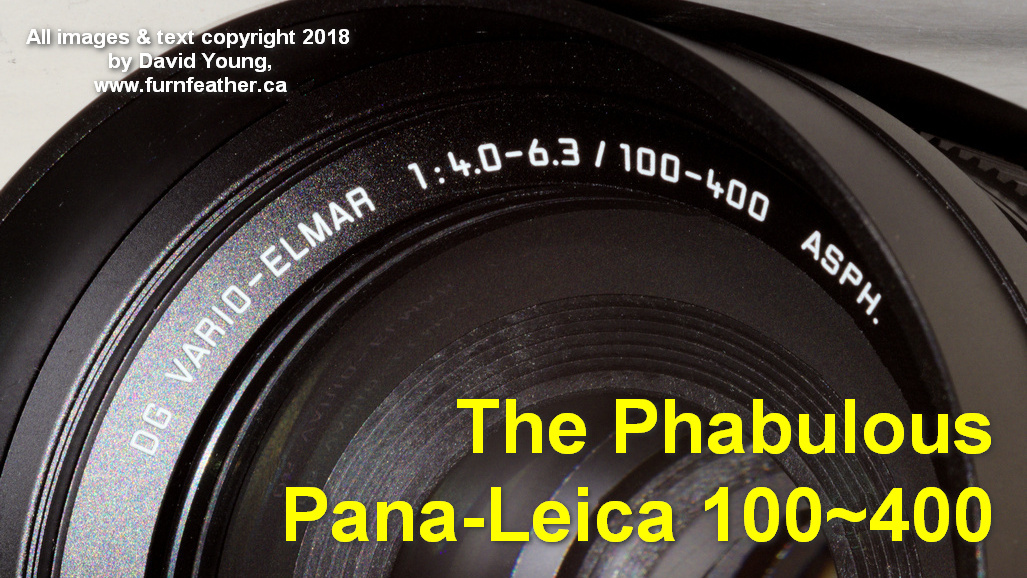| ely |
Compared to Leica's 400mm Telyt
- on the Olympus E-M1 Mk II.
(Tested
with Firmware v.1.3 on the E-M1 Mk II & v.1.2 on the Leica
Vario-Elmar.) Please note: This is the main review. There is also an update, 1 year on, here. \
For
the last twenty years, I have shot wildlilfe on a semi-professional
basis and my go-to lens over all those years has been Leica's
400/6.8 Telyt.
Why,
you might ask, would anyone use a nearly 50 year old, manual focus
lens, when so many
newer, brighter alternatives are available? Well, it's
incredibly light (a
2-element achromat means a lot of air inside the tube),
quick to focus (the "trombone
focus" works almost as quickly as auto-focus, once
you're used to it) and it's incredibly sharp. (It is, after all, a Leica lens!)
Sharp enough, in fact, to be produced from the late 1960s, right up to
1994. It
also
doesn't
hurt that the Tely's are available used, at
quite
reasonable (for Leica)
prices. This last bit means you don't
panic quite as much when you take it boonie-bashing in the woods,
looking for
birds and beasts.
For those who want to know more about the Telyt, a pdf of my review,
written years ago for Viewfinder magazine, can
be downloaded by clicking
here.
Now, I've
been behind a camera for almost 60
years, taking photographs in some 33 countries. I've taught photography
from New York to San Francisco and been a guest
speaker or presenter at
photographer's conventions in Germany, across the US and in my native Canada. (A short bio, if you're
interested, is here.)
In other
words, the "side
benefit" of
all of this is that I'm getting older. I've
traded my
Leicas for Olympus OM-Ds and most of my Leica glass has
slowly morphed
into smaller, lighter Olympus glass. But, I've held on to the
Telyt,
because it simply can't be beat. Or can it?
For
the last 10 years, the Olympus 50~200 f2.8-3.5 SWD has been my go-to
lens for almost everything other than wildlife. That, and the matching
1.4x
teleconverter. And as time went on, it gradually replaced the Telyt for
wildlife,
simply because it has autofocus - even if it lacked the "reach"
at
just 280mm (with the 1.4x).
Recently
I've found myself wanting something that
would replace both my 50~200+1.4x AND
my Telyt, making my bag both
smaller and lighter. Yet, regaining the "reach" of the 400mm
Telyt. Having auto-focus would be nice,
too.
Panasonic's
Leica-branded 100~400 zoom
looked like the answer. The early reviews have said many good
things, but several
problems seemed to crop up when this Panasonic beast is used with the
Olympus
OM-D EM-1 camera bodies - especially on the Mk II version.
So, let's take a look.
How
does it stack up?
Fit
and finish are up to Leica standards ... The lens is impeccably finshed
and it simply feels good, in the hand.
Despite
being a mostly metal or metal clad lens (the lens extension tube is a
high-grade plastic,
as it is with my Olympus 50~200), the lens is light (just 1027 grams,
or 36 ounces, including the very nice - if plastic - accessory lens
hood.)
For 20 elements, in 13 groups, that's amazing!
Compare
that with 1380 grams, or 48 oz, (with
mFT adapter - apples to apples), for 2 elements in 1
group and you can see the difference!
The
major thing in an auto-focus lens is AF speed. (Accuracy depends more on
the camera body.) For years the gold standard has been the "sonic ring motors". Canon call them USM, Nikon use SWM, |
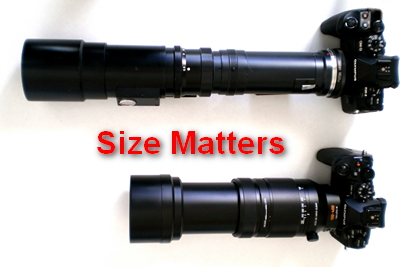
|
Sigma's are HSM and Olympus call them SWD, etc.
They are fast, silent and expensive. Micro-motors were
relegated to the cheaper models, with slower
AF.
But,
with newer, faster micromotors and the advent of internal focusing, those days are
gone. In good light, the Pana-Leica
100~400 is lightning fast. In poor light (say, just a
couple of 60 watt lamps in a decent sized living room),
I can't describe the AF as "lightning fast" (mostly because of the
f4 to f6.3 maximum aperture) but with
the E-M1 Mk II, it is still respectably
quick and very
accurate, without any hunting.
In
fact, the ONLY time I've been able to make the lens "hunt" is when I've
tried to focus on something close, but had the focus limiter set to 5
meters & beyond. And that's not a problem with the
lens,
that's a problem with me!
For those not familiar
with internal
focusing, it means that only a few smaller, lighter, internal elements are moved
- and not very far.
The lens
does not change in size, nor do the front elements rotate as it
focuses. Internal focusing also makes it easier to effectively weather
seal
the lens.
There
is a small, built-in, collapsible, metal hood, but it's not very deep.
While better than
nothing, it's no great joy. The included, larger hood fits
over the built-in hood & is
secured by a thumb
screw, which is OK. It can be reversed, for storage and should
be used at all times.
Winter 2019 UPDATE: I
wrote that last line because it's been standard advice since I started
shooting back in the 1960's. But, on a recent trip to eastern
Europe, I had to forgo the larger hood and stick with just the built-in
one, due to space limitations.
I
need not have been concerned. The Leica DG Vario 100~400 is
probably the most flare resistant lens I've ever used! Check out
the image of industrial cranes taken just prior to sunset, near Rousse,
Bulgaria. Shot directly into the sun, yet there is not a trace of
flare!
Many
reviewers have decried the lack of a reversible, bayonet mount for the
hood, but it's hard to see how that would have been possible for the
designers. As it is, the situation is adequate, if not
perfect. Though I would have preferred that the hood
be made of metal, not plastic.
On
the other hand, the ability to easily swing the camera from
horizontal
to vertical on a tripod or monopod is a delight! You can do
it
easily; and if you're using a bottom mounted battery pack
that
gets in the way, Panasonic have thoughtfully provided a small extension
for added
clearance. Very nice. This is something
that the Telyt
does,
but which is usually only seen if an (often) optional tripod collar is
used.
Panasonic have built it in, seamlessly.
Both the
zoom and manual focus rings are metal and nicely ribbed, as is the
locking ring. The lock-ring is meant to lock the lens so that
the
lens does not extend downwards, by gravity, when carrying your camera
with the lens
head aimed down. Unlike many such rings, which only
work
at infinity, the
Leica's ring will lock at any focal length... useful
when doing repetitive work
(say shooting horses coming over a
jump) and you don't want things to change between shots. | 
Image Copyright: 2019 by David Young. |
Video
Concerns:
B
Zooming is
a wee bit stiff ... not silky smooth like the Olympus 40~150 PRO.
Stiff enough that, in my experience, the lens does not
"drift"
downwards, even when carried lens down, without the lock being set.
On
the other hand, it is not as stiff as the Olympus 50~200-SWD, that I've
used
for the last decade. And, if it does loosen up, the lock-ring may well
be needed.
Don't get
me wrong ... the zoom is easy to use and
more than smooth enough for a stills photographer, such as myself.
But, if
you wish to shoot video with it, it will give you a jerky movement as
you zoom. Some folks have said that after a year, it smooths
out... others say not. For me, it matters not, as I never
shoot
videos and for adjusting the zoom between shots, it's plenty smooth
enough. But, it's worth noting, if you plan to shoot videos. (Update:
After 7 months and many thousands of shots, it is slowly improving -
but I still would not recommend it for video use.)
However, on my sample, at
least, I
can hear the micromotor as it focuses the lens. It's
faint, but it's
audible. It won't bother a stills photographer, but, again, it's worth
noting as the that sound may well turn up on your sound-track if you
shoot videos. (My advice
for video shooters? Buy from your local dealer and try before you buy.)
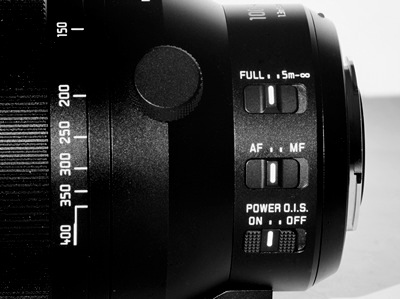
|
On the plus side, the
zoom ring is precisely
calibrated, with the focal length markings (every 50 mm)
corresponding exactly to the EXIF information provided.
Controls, from top down, consist of a focus limiter switch,
the AF-MF switch and the Power OIS switch.
In
reverse order... various early reviews suggest, and my own experience
confirms that the POWER OIS does a better job of stabilizing this lens
than the Olympus' IBIS system - at least at the longer focal lengths.
Thus, it's best to set
"Lens
IS Priority" to ON. This means that when the
lens has IS
built-in,
the IBIS system is turned off and the lens IS is used. When you mount
an Olympus lens, without IS built in, the IBIS system turns back on,
automatically.
Sadly,
the IBIS and OIS systems will not work together, for even better
|
image
stabilization. That only works with Panasonic lenses on
Panasonic cameras or Olympus lenses on Olympus bodies.
Panasonic
recommend turning the OIS off, when the lens is on a tripod. However, I
have found that even on my quite sturdy Manfrotto tripod, there is
sufficient movement (vibration) at the 400mm
position,
if only from wind, that the
OIS is still beneficial.
The
Auto/Manual focus switch is nice in that it is electrical, so if you
turn the
Manual focus ring while AF is engaged, or when the camera is off,
nothing happens. On some lenses, the
AF-MF switch locks a gear - and if you turn
the manual focus ring, while
AF is turned on, you can damage the lens. Not so with the
Pana-Leica.
Actually focusing manually is a focus-by-wire system. It is
very accurate, with no noticeable backlash or
overshoot... hard to do in a focus-by-wire system. And, because Depth
of Field is so limited at 400mm, the fine, manual focus adjustment is
highly
desireable. However, the AF is so accurate, I doubt you'll ever use it!
|
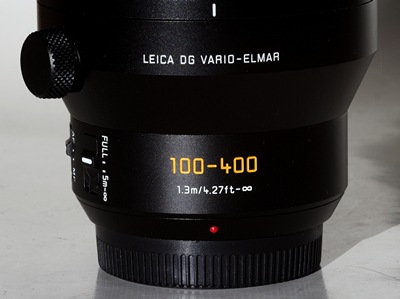 |
THE
NON-ISSUE: Last,
but by no means least, is the focus limiter. This was the
source
of a major bugaboo, early in the game. Several
reviews that
are
still
available on the web, state that if the lens is used with the Olympus
OM-D EM-1 MK II, and if the limiter is set to 5m-Infinity,
the lens locks up and the IS makes some
very strange noises and/or vibrations.
The 100~400 could only be used if the focus limiter was set to "Full".
And it
was true.
The
solution, they said, was to keep the lens set at "full", and use the
focus limiter found in the Mk II's
menus, instead. That worked, but the menus are slow to change
and thus
awkward in real life photography.
However, Panasonic's firmware update 1.2 for
the
lens has solved this issue.
My lens came with
1.2 already installed
and has worked perfectly with the Olympus from the start. If
you
have an ealier firmware version on your lens, do the update!
In the photos
above and to the right, you can see the knurled knob that allows the
camera to be rotated to vertical or horizontal, while on a tripod or
monopod.
Performance:
The biggest
problem I've had with this lens, has nothing to do with the
lens, or the camera. It has to do with the weather.
Simply
put, I live in Canada's frozen north. Climate change has
meant that, here in BC,
the
winter
has not been cold enough. And my favourite test of any lens or camera,
at this time of year, is the ice racing. The crazies who race
their motorcycles across
frozen
lakes, at up to 80kh (50 miles per hour), at temperatures of -20C or
colder. In theory, the Ice racing season is on now, but the
first two
weekends were
cancelled due to a lack of ice. It's been too warm and the ice
is
insufficient to hold 100+ pickup trucks, a few cars and 40
to 50 motorcycles. (If
you want to see what these crazies do, see my earlier review of the EM-1 Mk II & the Olympus 50~200 SWD, found here.)
So,
for this review we're going to have to settle for some hand-held images
I took at -30C (-22F, if you prefer) on Christmas Day, 2017 at our son's Alberta farm. (This is our daughter-in-law,
preparing to feed her cows.)

and below is a 100%
crop
from the shot above.
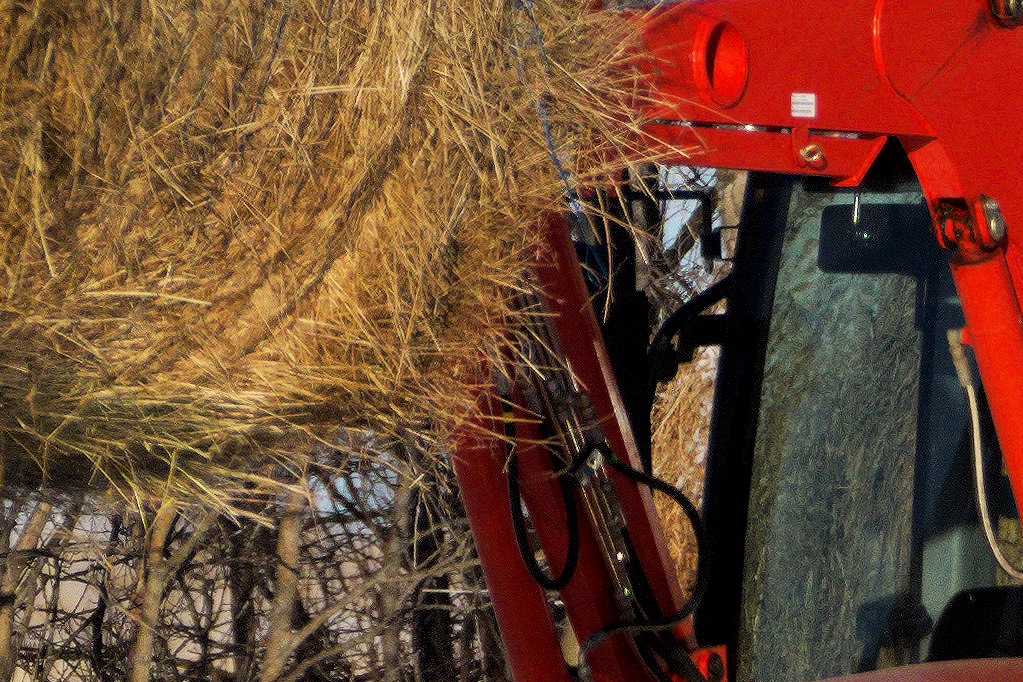
Remember,
this is hand-held, at -30C and my hands shake at those temperatures.
Photo:
267mm @ f 5.5
(wide open) - 1/2500th of a second. ISO 500
NO
SHARPENING WAS APPLIED TO THESE IMAGES.
February 2019 update: We
may have missed the Ice Racers this year, but after this
review was written we had a couple of "Free-style" snowmobilers
come through our little town, to put on a show for our annual "Polar
Carnival".
|
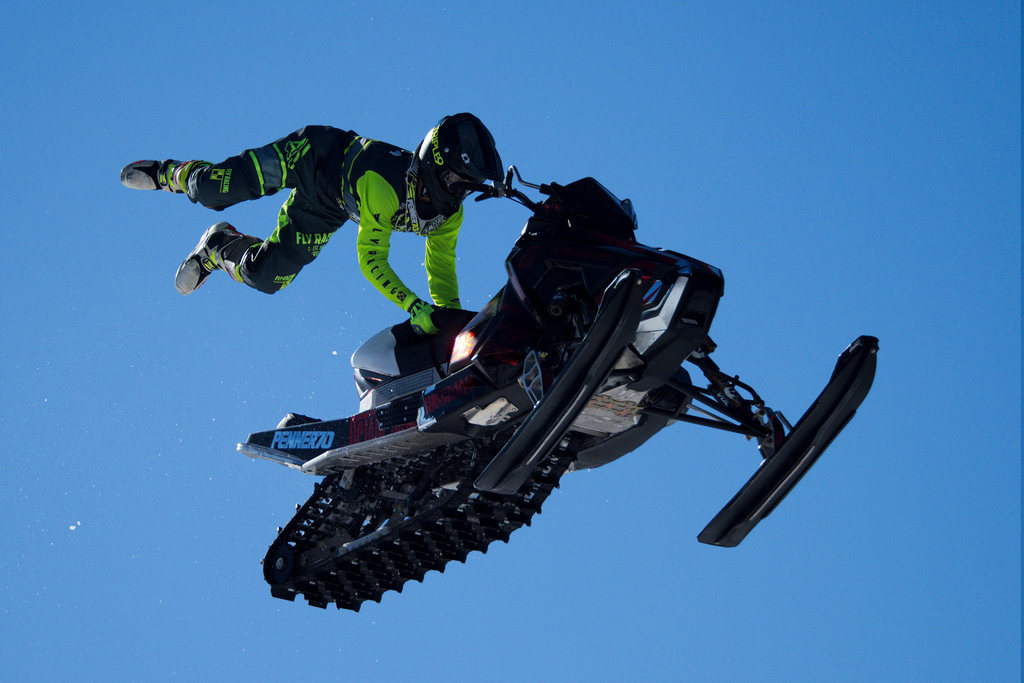
These
two snowmobiles were about 40 feet (roughly 12 meters) in the air!
Taken on Feb. 10th, 2018, hand held, with the DG Vario-Elmar 100~400
@100mm.
Both at f4.5
& ISO 640. Top: 1/5000th. Below: 1/8000th.
Electronic Shutter.
Temp: -21C (-6F)
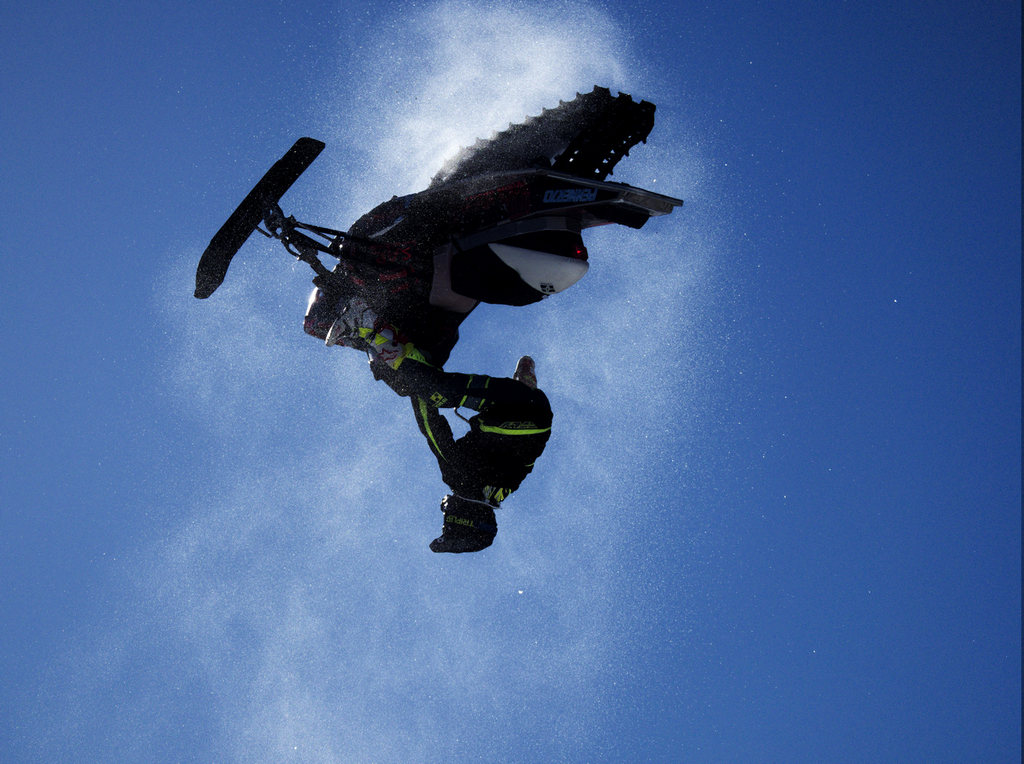
All photos (c) 2018
David Young - all rights reserved.
www.furnfeather.ca.
NOTE : There is also a "one-year-on" update to this review, which contains a number of images from
the 2019 Ice Racing Season, here.

|
COMPARISONS WITH
LEICA'S 400mm f6.8
TELYT...
Finally,
lets take a look at some comparison shots between the Pana-Leica and my
"gold standard"... Leica's 400/6.8 Telyt.
Ugly as they are, both shots were nade from just
inside my front door (open, despite the -6C temperature!) and
look at the mess that is my
neighbour's car port, across the road. So, roughly 150 to 165
feet (45 to 50 meters) away. The shot at the left is the
full veiw at 400mm.
The
crop, below, is from a duplicate shot, made with the Telyt,
but without moving the tripod, while the Pana-Leica crop
(further below) is a crop from the shot at the left.
A small amount of USM sharpening (6% at 0.5 pixel radius)
has been applied to each of the crops. Othewise, both were
developed
without "tweaking" of any kind.
I
think you'll agree, that the Telyt does amazingly well, for
a 50 year
old design. |
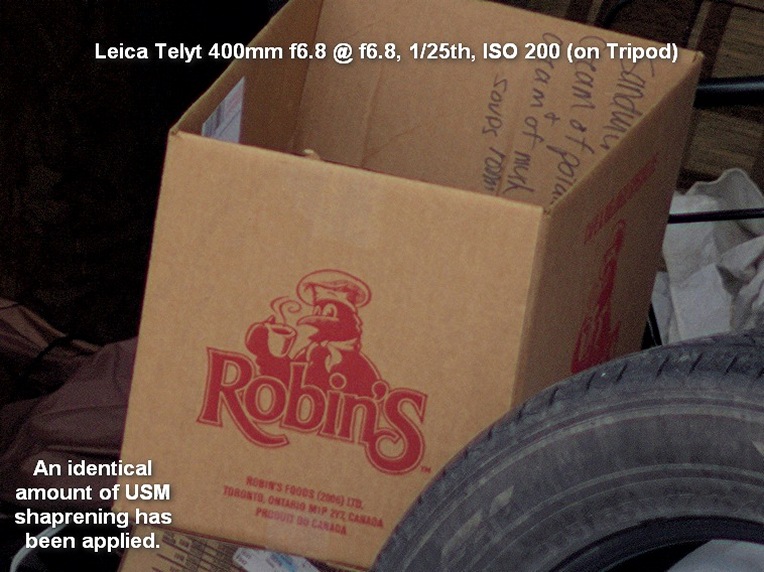
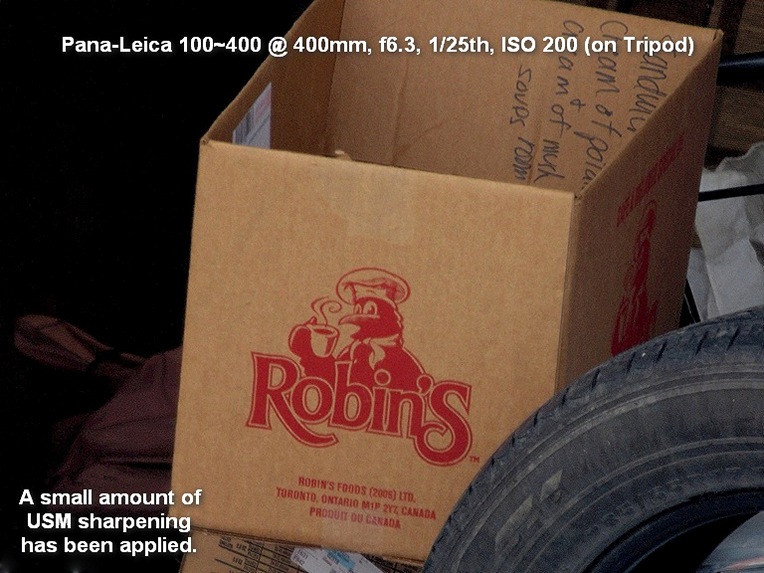
But, I think you'll also
agree that the
Panasonic-Leica zoom is slightly sharper and with a bit better contrast. (Try
to read the small print, at the bottom of each box!)
Remember,
both of these images were taken wide-open, because neither lens can be
described as a "fast" or "bright", with their maximum apertures at f6.3 and f6.8 at 400mm. So,
in the woods, that's
how they'll most often be used. On a bright summer
day, you can stop down a bit and sharpness on both should improve.
However, when
you consider what portion of the shot is the box; that we're
shooting a logo that is
about 6" (15cm) high & not even square to the
camera; at
a distance of 150 to 165 feet, you can see that both lenses
offer
outstanding, professional-grade performance.
December 2019 update: I have now had the Panasonic-made, Leica Leica 100~400
DG Vario-Elmar for two years. And I still love it. It took
a fall of about a meter (~3 feet) on to some fairly soft dirt, in
August. That scared me, but the lens is rugged enough that it
continues to work perfectlly.
In November, my wife and I completed a 3 week trip up the Danube
River, from Romania through Bulgaria, Serbia and into Hungary. I
took only two lenses ... the Olympus 12~40/2.8 PRO and
the Leica 100~400 Vario-Elmar. I did not
take a monopod or tripod ... every shot was hand-held. It turned out to be a brilliant combination!
I
have assembled an album on Flickr - which holds images from that trip,
as well as many more from my personal collection - all taken with the
Leica
100~400 Vario-Elmar and almost every one hand-held. If you really want
to see what this puppy can do, in the real world, the album can
be seen here. (Click on any image, for a bigger view.)
If you're an arm-chair traveler and wish to see all my images from this trip, you are welcome to click here.
Conclusion:
The
Panasonic/Leica 100~400, f
4-6.3 zoom is not an inexpensive piece of kit.
Will it outperform it's major competition in wildlife
work, the 300mm f4 Olympus PRO?
I've not tested the 300/4, but I doubt
it. But then again, the 300mm f4 PRO is a full $1000
more than
I paid for my Pana-Leica! And, it's a prime lens of the most
modern design.
With the sole exception of Leica's APO-Vario-Elmarit-R
70~180/2.8
- which is no longer available new, but which will presently set you
back roughly US$8,000 for a used one - Zooms just aren't as good as
top-notch, prime lenses. Period. But, the best of them are getting quite close.
Don't
forget, that these tests were performed at the long end of the
Pana-Leica's range,
where all zooms do their worst. At shorter focal lengths, the
lens gets nothing but better!
Even so, the Leica DG
Vario-Elmar 100~400 outperforms the Leitz
400/6.8 Telyt - if only by a small amount - and offers the conveniences of Autofocus, lighter
weight and smaller size; as well as the ability to replace two, or
more,
lenses in your bag. It also offers an insignificant 1/3 stop brighter
image, at the 400mm settting. (Be
still, my beating heart!)
While
the Telyt delivers pro-quality optics, even today, it is a nearly 50
year old, manual focus design. But, it becomes an image
stabilized
lens, when it's used on an older FourThirds or newer mFT body with In-Body Image
Stabilization!
The
Telyt is a "long-focus" design, not the more compact, telephoto design
.While I have managed it (only during testing), it is physically long
enough that simple leverage makes it almost impossible to
hand-hold. And, because it is a simple, cemented pair achromat,
it also suffers from some curvature of field, though
that only shows on a Full Frame camera. On a mFT body, you'll never see it, as you're using only the "sweet spot", in the middle!
By
comparison, the Panasonic/Leica DG Vario-Elmar 100~400, is
shorter, lighter and easily hand-holdable, even at the full 400mm limit!
The
Panasonic/Leica DG Vario-Elmar 100~400 zoom does slightly better in
both sharpness and contrast, though the Telyt's somewhat lower contrast can be easily remedied in
post
processing and the sharpness difference is not huge. Truth be told, with a
subject that fills most of your frame, you'll have a hard time telling one from the other!
So, if you have the need, or just the desire, for a
400mm
lens and your budget is
tight
... look long, hard at a used Telyt 400/6.8 ($400 to $600 on eBay, these days)
with a Leica-R to mFT adapter (under
$15 on eBay).
If you're willing to focus manualy and use it on a monopod, its performance can't be beat
for the price.
However, if you want the
flexibility of a zoom, with auto-focus and all the
"mod-cons"; slightly better performance, and a smaller,
hand-holdable size & weight .... and your
budget
will stand the price, the LEICA's 100~400 DG
Vario-Elmar, f4-6.3 zoom
will prove
very, very difficult to beat!
In
the 5 months that I've had the Vario-Elmar, I have used it extensively,
on everything from Rodeo's to wild-fires. It has proven to be an
excellent lens, that can be easily and reliably hand held, with
excellent results - something just not possible with the Telyt, yet
with the "reach" of the Telyt. It has the "reach" of the Telyt and the convenience of the
50~200 Zuiko, without needing to fuss with the 1.4 converter.
If
there is a problem, it is the gap between my 12~40/2.8 Zuiko PRO and
the 100mm minimum FL of the Vario-Elmar. Fortunately, I already own the
superb 75/1.8 m.Zuiko, which is getting more use these days, and which
fills that
gap, admirably. However, the more I use the 12~40/2.8 PRO and the
100~400 Vario Elmar, I find the 75 is only rarely needed as, for most
purposes, the gap can be filled by cropping from the 12~40.
Still, nice to have when a truly fast (f1.8) lens is needed.
(My review of the 75/1.8 m.Zuiko is here, if you're interested. My review of the 24~40/2.8 PRO is here.)
Panasonic's LEICA DG 100~400 Vario-Elmar is so good, that after just 10 weeks with the
Vario-Elmar, I sold my Telyt AND my 50~200 f2.8-3.5 SWD Zuiko!
I think that says more than anything else.
|
Please note: This is the main review. There is also an update, 1 year on, here.
Thanks
for reading.
Originally written: Jan. 2018. Last
updated: 17 February, 2020
If
you found this, or any of my reviews, helpful, please consider
supporting this effort by purchasing my e-book.
"A Brief History of Photography"
is just what it says it is. Fast paced, entertaining &
easy to read, yet it covers the history from 1614 right to the end of 2020. It is, by
far, the most complete, up-to-date, history of photography, anywhere.
Spanning the equivalent of 450+ printed pages, it covers not only the chemistry, but the seminal cameras, films,
sensors, lenses and accessories of their day.
It includes hundeds of "Trivia" & "Oddities" entries - which offer little-known
background stories on both
the inventors & their inventions.
Profusely illustrated.
To read a free preview, click on one of the links, below.
(Apple users use Apple Books, Windows & Android users please use Kobo.)
 
|  |
If
interested, you
can
also find my antique Debrie
Sept
and 1950 Beauty
Six (one
of only two
known
to exist in the world)
at Camer-Wiki.org.
|
|
Disclaimer:
I
have no connection with Panasonic, Leica or any other manufacturer,
other than as a user of their products. I do not receive any payment if
you buy any of the products mentioned. The opinions expressed are
entirely my own.
|
|
A |
|




